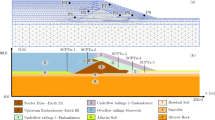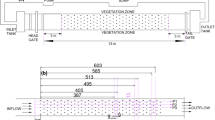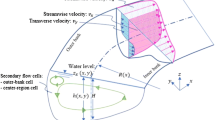Abstract
In flash flood events, predicting the impact loads of rushing water is helpful to detect the possible and direct damage to the downstream structures. The present study conducted three-dimensional numerical simulations for three typical laboratory experiments with emphasis on the hydrodynamic impact. Two RANS-based k-ε models and the LES model were chosen for the turbulence closure. The VOF method was applied to track the free surface. The numerical model provided satisfactory results of the temporal variations of both water depth and hydrodynamic load, which are in great agreement with the experimental data. Further quantitative comparisons also show that the deviations between simulations and experiments are small. The values of performance indicators mean-absolute deviation (MAD), root-mean-squared deviation (RMSD) and mean-absolute percentage deviation (MAPD) are respectively lower than 0.05 (0.03 m), 0.08 (0.048 m) and 19% for depth prediction, lower than 0.05 (0.03 kPa), 0.11 (0.06 kPa) and 11% for pressure prediction, and lower than 0.7 N, 1N and 15% for net force prediction. The absolute values of relative percent deviation (RPD) are less than 27% and 25% for the prediction of peak pressure and peak net force, respectively. The values of Nash–Sutcliffe efficiency (NSE) for depth and pressure are higher than 0.8. Moreover, the impulse of pressure or net force exhibits better predictability than its instantaneous values. Additional investigation shows that the time-varying behaviour of the impact force are significantly affected by the upstream initial depth, and the maximum impact force has a quadratic relationship with the initial depth.
















Similar content being viewed by others
Availability of Data and Materials
Not applicable.
References
Aleixo R, Soares-Frazão S, Zech Y (2011) Velocity-field measurements in a dam-break flow using a PTV Voronoï imaging technique. Exp Fluids 50:1633–1649. https://doi.org/10.1007/s00348-010-1021-y
Aureli F, Dazzi S, Maranzoni A et al (2015) Experimental and numerical evaluation of the force due to the impact of a dam-break wave on a structure. Adv Water Resour 76:29–42. https://doi.org/10.1016/j.advwatres.2014.11.009
Aureli F, Maranzoni A, Mignosa P, Ziveri C (2008a) A weighted surface-depth gradient method for the numerical integration of the 2D shallow water equations with topography. Adv Water Resour 31:962–974. https://doi.org/10.1016/j.advwatres.2008.03.005
Aureli F, Maranzoni A, Mignosa P, Ziveri C (2008b) Dam-Break flows: acquisition of experimental data through an imaging technique and 2D numerical modeling. J Hydraul Eng 134:1089–1101. https://doi.org/10.1061/(ASCE)0733-9429(2008)134:8(1089)
Begnudelli L, Sanders BF (2007) Simulation of the St. Francis Dam-Break Flood. J Eng Mech 133:1200–1212. https://doi.org/10.1061/(ASCE)0733-9399(2007)133:11(1200)
Chen HY, Xu WL, Deng J, et al (2014) Experimental investigation of pressure load exerted on a downstream Dam by Dam-Break flow. J Hydraul Eng 140:199–207. https://doi.org/10.1061/(ASCE)HY.1943-7900.0000743
Cummins SJ, Silvester TB, Cleary PW (2012) Three-dimensional wave impact on a rigid structure using smoothed particle hydrodynamics. Int J Numer Methods Fluids 68:1471–1496. https://doi.org/10.1002/fld.2539
Eaket J, Hicks FE, Peterson AE (2005) Use of stereoscopy for dam break flow measurement. J Hydraul Eng 131:24–29. https://doi.org/10.1061/(ASCE)0733-9429(2005)131:1(24)
Elkholy M, LaRocque LA, Chaudhry MH, Imran J (2016) Experimental investigations of partial-breach dam-break flows. J Hydraul Eng 142:04016042. https://doi.org/10.1061/(ASCE)HY.1943-7900.0001185
Fraccarollo L, Toro EF (1995) Experimental and numerical assessment of the shallow water model for two-dimensional dam-break type problems. J Hydraul Res 33:843–864. https://doi.org/10.1080/00221689509498555
Frazão SS, Zech Y (2002) Dam Break in Channels with 90° Bend. J Hydraul Eng 128:956–968. https://doi.org/10.1061/(ASCE)0733-9429(2002)128:11(956)
Haltas I, Elçi S, Tayfur G (2016) Numerical simulation of flood wave propagation in two-dimensions in densely populated urban areas due to dam break. Water Resour Manag 30:5699–5721. https://doi.org/10.1007/s11269-016-1344-4
Hirt CW, Nichols BD (1981) Volume of fluid (VOF) method for the dynamics of free boundaries. J Comput Phys 39:201–225. https://doi.org/10.1016/0021-9991(81)90145-5
Hu KC, Hsiao SC, Hwung HH, Wu TR (2012) Three-dimensional numerical modelling of the interaction of dam-break waves and porous media. Adv Water Resour 47:14–30. https://doi.org/10.1016/j.advwatres.2012.06.007
Issakhov A, Borsikbayeva A, Issakhov A (2022) Dam-break flow on mobile bed through an idealized city: Numerical study. Water Resour Manag 36:4425–4446. https://doi.org/10.1007/s11269-022-03253-7
Issakhov A, Zhandaulet Y (2020) Numerical simulation of dam break waves on movable beds for various forms of the obstacle by VOF method. Water Resour Manag 34:2269–2289. https://doi.org/10.1007/s11269-019-02480-9
Khan FA (2010) Two-dimensional shock capturing numerical simulation of shallow water flow applied to dam break analysis. Thesis, Loughborough University
Khoshkonesh A, Nsom B, Bahmanpouri F et al (2021) Numerical study of the dynamics and structure of a partial dam-break flow using the VOF method. Water Resour Manag 35:1513–1528. https://doi.org/10.1007/s11269-021-02799-2
Kleefsman KMT, Fekken G, Veldman AEP et al (2005) A Volume-of-Fluid based simulation method for wave impact problems. J Comput Phys 206:363–393. https://doi.org/10.1016/j.jcp.2004.12.007
Kocaman S, Evangelista S, Viccione G, Güzel H (2020) Experimental and numerical analysis of 3D Dam-Break waves in an enclosed domain with a single oriented obstacle. Environ Sci Proc 2:35. https://doi.org/10.3390/environsciproc2020002035
Kocaman S, Ozmen-Cagatay H (2012) The effect of lateral channel contraction on dam break flows: Laboratory experiment. J Hydrol 432–433:145–153. https://doi.org/10.1016/j.jhydrol.2012.02.035
Kocaman S, Ozmen-Cagatay H (2015) Investigation of dam-break induced shock waves impact on a vertical wall. J Hydrol 525:1–12. https://doi.org/10.1016/j.jhydrol.2015.03.040
Larocque LA, Imran J, Chaudhry MH (2013) 3D numerical simulation of partial breach dam-break flow using the LES and k-ε turbulence models. J Hydraul Res 51:145–157. https://doi.org/10.1080/00221686.2012.734862
Lauber G, Hager WH (1998) Experiments to dambreak wave: Horizontal channel. J Hydraul Res 36:291–307. https://doi.org/10.1080/00221689809498620
Launder BE, Spalding DB (1974) The numerical computation of turbulent flows. Comput Methods Appl Mech Eng 3:269–289
Lobovský L, Botia-Vera E, Castellana F, et al (2014) Experimental investigation of dynamic pressure loads during dam break. J Fluids Struct 48:407–434. https://doi.org/10.1016/j.jfluidstructs.2014.03.009
Marsooli R, Wu W (2014) 3-D finite-volume model of dam-break flow over uneven beds based on VOF method. Adv Water Resour 70:104–117. https://doi.org/10.1016/j.advwatres.2014.04.020
Mazzorana B, Simoni S, Scherer C, et al (2014) A physical approach on flood risk vulnerability of buildings. Hydrol Earth Syst Sci 18:3817–3836. https://doi.org/10.5194/hess-18-3817-2014
Mokrani C, Abadie S (2016) Conditions for peak pressure stability in VOF simulations of dam break flow impact. J Fluids Struct 62:86–103. https://doi.org/10.1016/j.jfluidstructs.2015.12.007
Munoz DH, Constantinescu G (2020) 3-D dam break flow simulations in simplified and complex domains. Adv Water Resour 137:103510. https://doi.org/10.1016/j.advwatres.2020.103510
Nash JE, Sutcliffe JV (1970) River flow forecasting through conceptual models part I — A discussion of principles. J Hydrol 10:282–290. https://doi.org/10.1016/0022-1694(70)90255-6
Ozmen-Cagatay H, Kocaman S (2011) Dam-Break Flow in the Presence of Obstacle: Experiment and CFD Simulation. Eng Appl Comp Fluid Mech 5:541–552. https://doi.org/10.1080/19942060.2011.11015393
Park I-R, Kim K-S, Kim J, Van S-H (2012) Numerical investigation of the effects of turbulence intensity on dam-break flows. Ocean Eng 42:176–187. https://doi.org/10.1016/j.oceaneng.2012.01.005
Peregrine DH (2003) Water-wave impact on walls. Annu Rev Fluid Mech 35:23–43. https://doi.org/10.1146/annurev.fluid.35.101101.161153
Shige-eda M, Akiyama J (2003) Numerical and Experimental Study on Two-Dimensional Flood Flows with and without Structures. J Hydraul Eng 129:817–821. https://doi.org/10.1061/(ASCE)0733-9429(2003)129:10(817)
Schubert JE, Sanders BF (2012) Building treatments for urban flood inundation models and implications for predictive skill and modeling efficiency. Adv Water Resour 41:49–64. https://doi.org/10.1016/j.advwatres.2012.02.012
Smagorinsky J (1963) General circulation experiments with the primitive equations. Mon Weather Rev 91:99–164. https://doi.org/10.1175/1520-0493(1963)091%3c0099:GCEWTP%3e2.3.CO;2
Soares-Frazão S, Zech Y (2007) Experimental study of dam-break flow against an isolated obstacle. J Hydraul Res 45:27–36. https://doi.org/10.1080/00221686.2007.9521830
Soares-Frazão S, Zech Y (2008) Dam-break flow through an idealised city. J Hydraul Res 46:648–658. https://doi.org/10.3826/jhr.2008.3164
Stamataki I, Zang J, Buldakov E et al (2018) Study of dam break flow interaction with urban settlements over a sloping channel. E3S Web Conf 40:06006. https://doi.org/10.1051/e3sconf/20184006006
Testa G, Zuccalà D, Alcrudo F et al (2007) Flash flood flow experiment in a simplified urban district. J Hydraul Res 45:37–44. https://doi.org/10.1080/00221686.2007.9521831
Thieken AH, Müller M, Kreibich H, Merz B (2005) Flood damage and influencing factors: New insights from the August 2002 flood in Germany: FLOOD DAMAGE AND INFLUENCING FACTORS. Water Resour Res 41. https://doi.org/10.1029/2005WR004177
Vacondio R, Aureli F, Ferrari A et al (2016) Simulation of the January 2014 flood on the Secchia River using a fast and high-resolution 2D parallel shallow-water numerical scheme. Nat Hazards 80:103–125. https://doi.org/10.1007/s11069-015-1959-4
Valiani A, Caleffi V, Zanni A (2002) Case Study: Malpasset Dam-Break simulation using a two-dimensional finite volume method. J Hydraul Eng 128:460–472. https://doi.org/10.1061/(ASCE)0733-9429(2002)128:5(460)
Van Leer B (1977) Towards the ultimate conservative difference scheme. IV. A new approach to numerical convection. J Comput Phys 23:276–299. https://doi.org/10.1016/0021-9991(77)90095-X
Wang B, Liu W, Wang W, et al (2020) Experimental and numerical investigations of similarity for dam-break flows on wet bed. J Hydrol 583:124598. https://doi.org/10.1016/j.jhydrol.2020.124598
Yakhot V, Orszag SA (1992) Development of turbulence models for shear flows by a double expansion technique. Phys Fluids Fluid Dyn 4:1510–1520. https://doi.org/10.1063/1.858424
Yang C, Lin B, Jiang C, Liu Y (2010) Predicting near-field dam-break flow and impact force using a 3D model. J Hydraul Res 48:784–792. https://doi.org/10.1080/00221686.2010.531099
Yeh H, Petroff C (2003) Bore in a box experiment. http://engr.smu.waves.edu/solid.html
Yilmaz A, Kocaman S, Demirci M (2021) Numerical modelling of the dam-break wave impact on elastic sluice gate: A new benchmark case for hydroelasticity problems. Ocean Eng 231:108870. https://doi.org/10.1016/j.oceaneng.2021.108870
Zhou ZQ, De Kat JO, Buchner B (1999) A nonlinear 3D approach to simulate green water dynamics on deck. Nantes, France
Acknowledgements
The present study was supported by National Natural Science Foundation of China (No. 52079086) and Natural Science Foundation of Tianjin (No. 20JCQNJC01960). The authors would like to appreciate the editors and anonymous reviewers for the editing and review.
Funding
This work was supported by National Natural Science Foundation of China (No. 52079086) and Natural Science Foundation of Tianjin (No. 20JCQNJC01960).
Author information
Authors and Affiliations
Contributions
All authors contributed to the study conception and design. Specifically, Ling Peng performed the numerical simulation, data curation and writing-original draft. Ting Zhang provided the conceptualization, methodology and data analysis. Jianzhu Li conducted analysis and writing- review and editing. Ping Feng reviewed and edited the original manuscript.
Corresponding author
Ethics declarations
Ethical Approval
Not applicable.
Consent to Participate
Not applicable.
Consent to Publish
Not applicable.
Competing Interests
The authors have no relevant financial or non-financial interests to disclose.
Additional information
Publisher's Note
Springer Nature remains neutral with regard to jurisdictional claims in published maps and institutional affiliations.
Rights and permissions
Springer Nature or its licensor (e.g. a society or other partner) holds exclusive rights to this article under a publishing agreement with the author(s) or other rightsholder(s); author self-archiving of the accepted manuscript version of this article is solely governed by the terms of such publishing agreement and applicable law.
About this article
Cite this article
Peng, L., Zhang, T., Li, J. et al. Three-Dimensional Numerical Study of Dam-Break Flood Impacting Problem with VOF Method and Different Turbulence Closures. Water Resour Manage 37, 3875–3895 (2023). https://doi.org/10.1007/s11269-023-03530-z
Received:
Accepted:
Published:
Issue Date:
DOI: https://doi.org/10.1007/s11269-023-03530-z




